Many people love search engine optimization, because it offers them the opportunity of getting free traffic to their websites. Sure, SEO doesn’t necessarily mean “free” traffic if you pay somebody else to do the work for you, because you don’t have enough free time at your disposal.
Nevertheless, by investing in SEO you are improving the quality of your website by creating useful articles, infographics, case studies, and so on, boosting its value and helping it attract free visitors even when the SEO campaign has ended. The alternative solution, be it AdWords or any other paid traffic source, will stop working the minute you run out of cash.
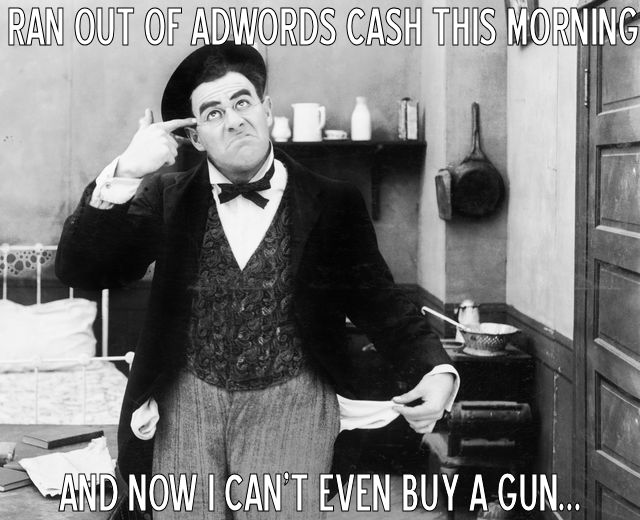
SEO is much better – there’s no doubt about that in my mind. Still, there’s this little animal called Penguin that’s completely under Google’s power and sends shivers down people’s spines every now and then.
With every Google penalty, be it Panda, Penguin, or whatever animal they want us to start hating, fewer and fewer people are doing SEO, and this is a good thing, because the search engine optimization arena is less and less crowded.
A History of Penguin Penalties
Everything started back in April 2012, when the first version of the Penguin filter was released, making lots of business owners and SEOs lose their website traffic and rankings.
Here are the dates of the Penguin penalties; bookmark and share this page, because it will be updated regularly as new Penguin updates are rolled out, and these dates will help you determine if your site was affected by those nasty penguins or not.
Penguin #7 – September 23, 2016, will update continuously from now on, without further announcements from Google.
Penguin #6 – October 17, 2014, impacting less than 1% queries.
Penguin #5 – October 4, 2013, impacting around 1% of queries.
Penguin #4 – May 22, 2013, impacting around 2.3% of queries.
Penguin #3 – October 5, 2012, impacting around 0.3% of queries.
Penguin #2 – May 25, 2012, impacting less than 0.1% of queries.
Penguin #1 – April 24, 2012, impacting around 3.1% of queries.
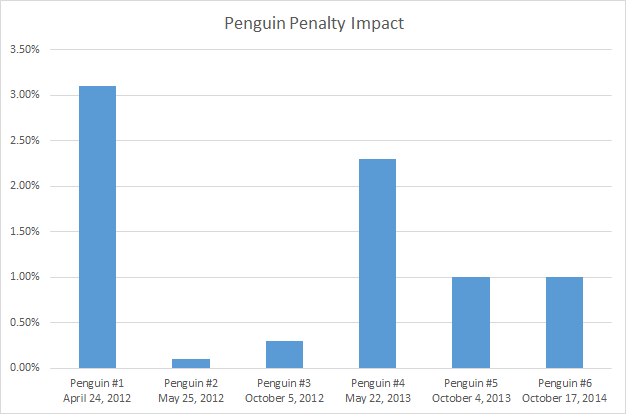
These percentages may not be that big, but they refer to the total amount of search engine queries. I don’t think that the “pink fluffy unicorns” search results will ever be disturbed by a Penguin penalty, but if you are active in a profit producing, AdWords crowded niche, the websites in that niche have been affected by one or more Penguin penalties for sure.
Who Needs Penguins?
When it comes to its search engine, Google is interested in two things: search results quality and money. And being a business owner myself, I’d dare to say that money is probably more important for Google than its search results quality.
In fact, these two aspects are intertwined, because if people lose trust in Google’s search results quality, they will stop using its search engine, and the advertisers will stop paying for ads.
So how do you maximize earnings if you own a search engine? You add as many paid ads slots as you can to the search results pages, while removing as many organic search results as you can. It’s a fine art; you have to keep the shareholders happy by earning more money, while making regular people believe that the search results aren’t biased at all.
Right now, Google displays a hefty amount of ads in profit-producing niches – see for yourself:
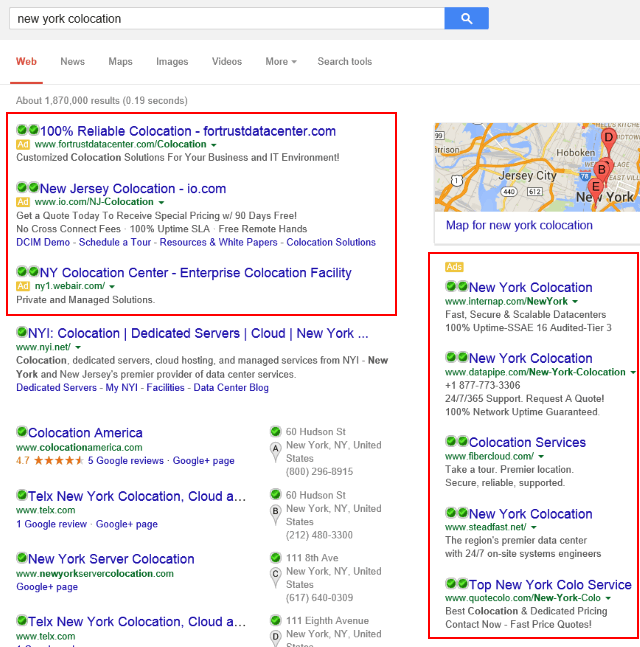
Basically, the niches where the AdWords CPC is big are filled with ads, results from Wikipedia, and so on, leaving only a few spots for organic search results, people that have ethically promoted their website, making it reach one of the top spots. On the other hand, the organic search results are crystal clear if people aren’t selling and buying anything in that particular niche.
Google is still trying to figure out the winning mobile advertising formula, but it looks like the experience that’s achieved while cramming a full site onto a small screen isn’t always pristine. And with mobile devices becoming more and more popular, it looks like Google’s search engine profit will not grow that much in the future.
As mentioned above, each penalty wave makes a few SEOs give up and a few website owners move from search engine optimization to AdWords. My guess is that Google wants to convert as many people as possible to paid search, but it needs to keep displaying some organic results on its pages as well.
I thought that it would be an interesting idea to correlate Google’s stock prices variations and its Penguin updates; here’s a diagram that I have created using the data provided by Nasdaq itself:
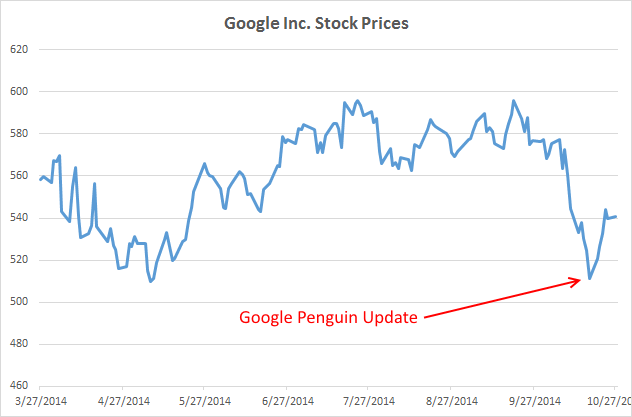
https://www.nasdaq.com/symbol/goog/stock-report
Google’s stock prices have grown quite a bit after the Penguin 6 update, isn’t it? It looks like the traders are quickly reacting to what is happening in the SEO world, and this Penguin update has made Google’s shareholders richer.
Penguin Penalty Triggers
OK, enough with the rants and rage! What triggers a Penguin penalty?
Before we begin, I have to repeat something I’ve already mentioned in some of my previous blog posts: the people working for Google are smart. Really smart! Some of them are probably smarter than you and me. And that is OK.
These smart people don’t get paid to play arcade games all day long; they use their intelligence to improve the spam detection algorithms, combining the data gathered from manual reviews with machine learning algorithms. Some people call this method supervised learning.

Basically, data about spammy / non-spammy sites collected by highly trained, human website reviewers is fed into Google’s program until the algorithm can take the spammy / non-spammy decisions by itself, with a set degree of precision.
Yes, Google’s spam detection algorithm isn’t perfect, and it will never be perfect. It can make mistakes from time to time, so your website may get penalized even when you didn’t do anything fishy. But as their algorithm improves and makes fewer and fewer mistakes, your website will recover if it was penalized by mistake.
At the other side of the spectrum we’ve got people that do SEO without knowing too much about it. They buy a $5 link building service or the $97 all in one SEO Guru Tool 15.2, they load their site in the program, push a button and – BAM! – they have gotten 1,000 low quality links pointing to their website.
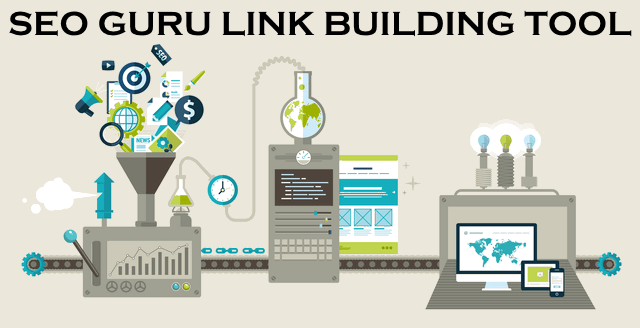
Do you think that Google’s spam detection algorithm, a piece of software that’s constantly being improved by some of the smartest people in the world, will buy that? I don’t think so!
If you create a lot of links in a short interval, you will trigger a Penguin penalty, now or in the future. Always use a small link building velocity when you are creating backlinks that point to your website.
It is important to understand that Google doesn’t want you to build any links to your site, though; it wants you to create fantastic content, which will attract great links on its own.
That is a lot of work, and very few people have the needed skills, time and money to do it. And even if you do create a fantastic piece of content, it’s not necessarily going to attract a lot of high quality links.
Take a look at this article, for example; it took me three days to put it together, it has over 4,000 words and I have done my best to give you as much useful information as possible, but I’m not sure if it will get a single retweet, share or backlink.
But Google wants you to do the things this way, because it wants its search engine index to be filled with beautifully crafted, accurate, useful resources. This makes their search engine useful and attracts advertisers in larger and larger numbers.
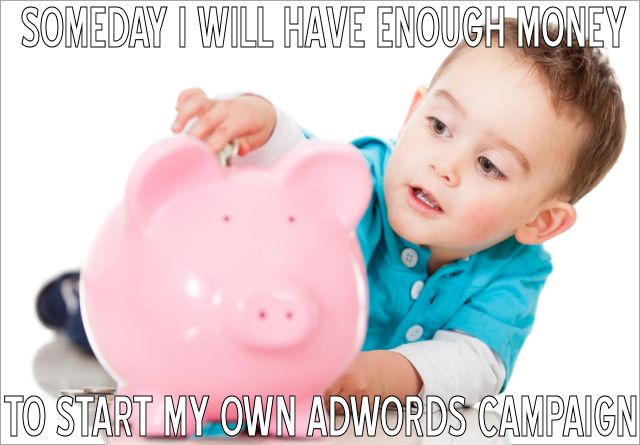
Whenever you hire someone to build links for you, make sure that those backlinks come from high quality sources.
Don’t ever use links that you can create on your own. Don’t ever use backlinks that everyone and their grandma are using.
If somebody sells a backlink building service, you are going to share his websites with hundreds or thousands of people, and Google will discover that sooner or later.
Don’t spam the web, unless you have a churn and burn SEO approach, so you don’t care about your website’s future.
Penguin examines the backlinks that are pointing to your website: it determines their type, the anchor text and the authority of the sites linking to you.
Google knows the websites that people are commonly using for their link building efforts. And if it determines that you are getting links from the same 50 websites used by 95% of the SEOs in the world, it will quickly determine that you are trying to spam your way to the top of its search engine.
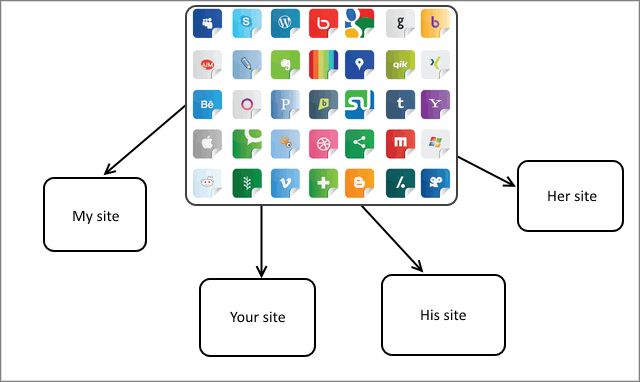
You may have learned that having a backlink from a PageRank 8 website like weebly.com will greatly help your SEO efforts, for example. I’m here to tell you to unlearn that; thousands of SEOs use automated tools to create Weebly blogs each day, so by doing that you’re just telling Google that you are a spammer as well.
The quality of your backlinks matters a lot. I always tell people to get niche related backlinks, but I would always be happy to get a backlink from the Yale University or New York Times, even if these aren’t SEO related websites. Their TrustRank value is huge, though, and this is even more important than relevancy.
Low quality links that can be built in large numbers are one of the most important Penguin triggers. If your website profile includes low quality directory links, forum profile links, Web 2.0 links, guestbook links, and so on, you are risking a Penguin penalty.
As a general rule, links that don’t add value to the web, links that aren’t surrounded by relevant text, links that come from low quality or deindexed sites are bad. Stop building them.
How does your anchor text profile look like? Link discovery tools like Ahrefs or Majestic SEO will help you find out if the next Penguin update will devalue your website or not.
Here are the top 25 anchors for Randombyte’s website:
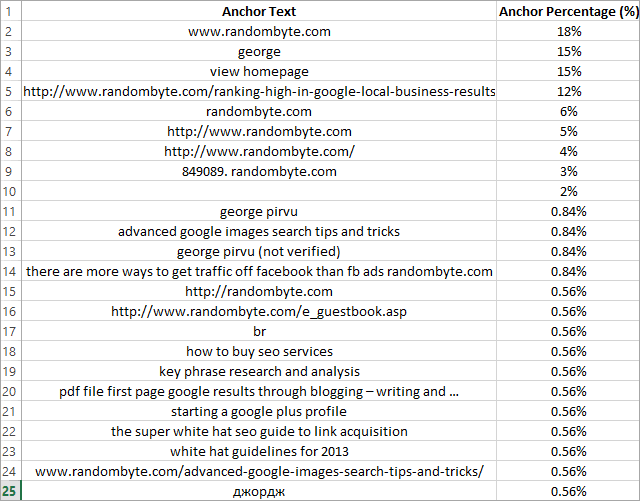
Can you tell what keywords I am targeting? Even I can’t do that! And this, my friend, is how 100% natural backlink building looks like. I don’t build any backlinks to my website – I let other people do that for me.
I simply create content, and then let people know about it. Many of my articles are ignored, but some of them have been picked up (and linked to) by Yale, GoDaddy, Wikipedia, and so on. It’s not the fastest way of getting to the top of Google, but Randombyte’s website has not been affected by any Google update, attracting more and more website visitors and leads.
As an added bonus, I get to sleep well at night, knowing that my site and my clients’ sites get 100% organic links, the way that Google wants them.
Let us assume that you want to rank for “fluffy puppy toys”. If you’d ask the gurus at the popular SEO forums how to set up your anchor text, they would give you a recipe that’s similar with this:
– 10% exact match anchor text – “fluffy puppy toys”;
– 30% related anchor text – “stuffed toys for puppies”, “toys for my puppy”, “fluffy pet animals”, etc;
– 40% branded and URL anchor text – “mysite.com”, “www.mysite.com”, “My Site”, etc;
– 20% generic anchor text: “click here”, “more info”, “this article”, etc.
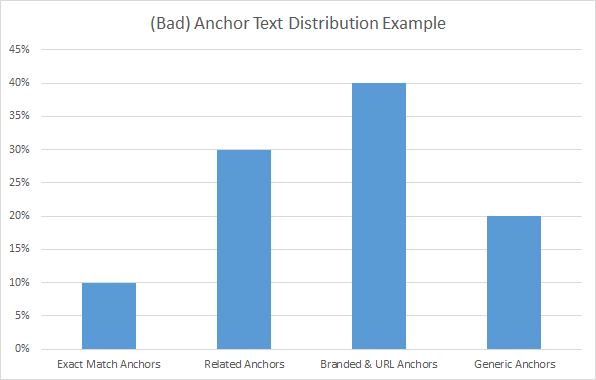
Actually, this anchor text distribution formula isn’t that bad, but it has a major flaw: it screams spam! A site with an anchor text profile like that may have survived this Penguin update, but it will surely tank in the future, as Penguin learns more about spam, and the people controlling its dials make it even more aggressive.
If your website has a good structure and good content, Google already knows the keywords you are interested in ranking for. Just plug your website URL into Google’s Keyword Planner, in the “Your landing page” field, and then press the “Get ideas” button.
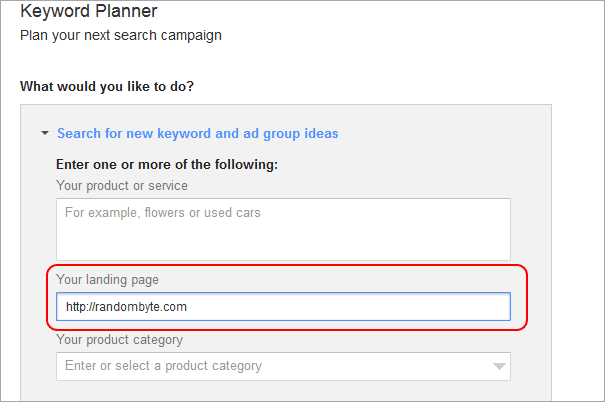
You will get a list of keywords that will accurately tell you how Google sees your sites when it comes to the keywords that you should advertise for. Of course, the very same keywords are perfect SEO targets as well.
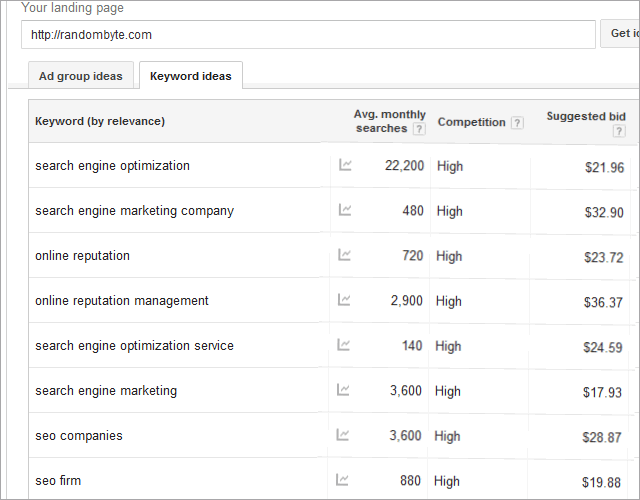
Don’t obsess over keyword-rich anchor text; otherwise, search engines will think that your site is spamming the web. Google already knows the keywords your site should rank for, based on its content.
Identifying a Penguin Penalty
Here’s a simple, two step method that will help you identify a Penguin penalty:
1) Log into your Google Analytics account (or the website traffic monitoring tool of your choice);
2) Look for significant organic traffic losses around the Penguin refresh date; if you see a big traffic loss, your website has been penalized.

The dates of the Penguin algorithm updates are listed at to the top of this article; don’t forget that I will update this article whenever a new update is rolled out.
Sometimes you will discover that your website got hit even though you haven’t built any links to it. If this is the case, your website may have some history of spam behind it, or maybe it was the target of a negative SEO attack in the past.
If your site is hit, its rankings will significantly decrease. Check your rankings for a week or two; if you have upset the Penguin, the keyword rankings losses will be significant.
Of course, if the website has only lost a few places, it wasn’t necessarily hit by the Penguin; a penalty will make your rankings drop at least 20-30 places.
To give you an example, a website that was ranking on the first page of Google may have dropped to the second page because some of its links were devalued, or because a few of the sites that were penalized by the Penguin in the past have regained their good rankings.
The reverse is true as well: if your site moves closer to the top, it doesn’t necessarily mean that your SEO has improved. Often times, your website starts to rank better because your competitors get knocked out of the SERPs.
Fixing a Penguin Penalty
OK, so your site got hit by the Penguin. What should you do now?
First of all, calm down – there is nothing that you can do right now. Wait for a few weeks before doing anything to fix the problem. Sometimes, your rankings will improve a bit as the new version of the algorithm is fully rolled out.
Don’t get your hopes too high, though; if your site has tanked, it will probably remain that way. Still, these two or three weeks of inactivity will help you get used to the idea of losing the rankings, allowing you to act while being driven by rationality, and not by feelings.
Many people react immediately, deleting their backlinks, uploading link disavow files, and so on. It’s a very wrong move, because it shows Google your list of self-built links.
Start building a list with all the backlinks that are pointing to your website. Use Ahrefs + Majestic SEO + Google Webmaster Tools to create the list, and then remove the duplicates. I use a Google Docs spreadsheet, because it allows me to show the clients how the penalty recovery work is progressing.
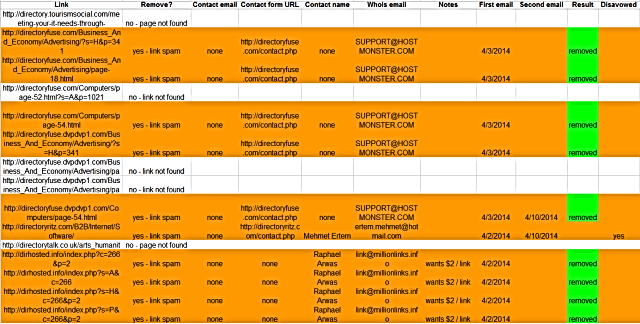
Sort the backlinks according to their domain; you don’t want to upset the webmasters, sending them several emails, as you discover that you’ve got more links than you were anticipating coming from the same source.
Then, sort the links according to the contact emails; you don’t want to upset the webmasters by sending them an email for each and every one of their domains that happens to link to your website.
Go through each link and evaluate its quality: if it is a link that you would happily show to a Google reviewer, keep it; otherwise, do your best to have it removed.
Get rid of directory links, forum links, group links, article directories links, irrelevant blog comments, links that come from articles using spun text, and so on. Of course, if you have links from reputable, industry-related directories, you should keep them.
All the links coming from directories like my-super-seo-backlinks-directory.com, etc, should be removed; having links from directories that contain the words “seo”, “links”, “backlinks”, etc in their domain names is really bad these days.
Don’t worry that much about nofollow links, unless they come from really spammy sources. Google doesn’t consider them to be too dangerous, because they don’t pass PageRank, so (in theory) they don’t influence search engine rankings. In fact, nofollow links can improve search engine rankings, but this is a story for another article.
Cleaning Your Toxic Backlinks
Here’s our four step approach to clean the toxic links:
1. We use in-house tools, web scrapers, and whois websites to determine the webmasters’ email addresses and names. I will use webmaster’s name in the email whenever I can find it; this way, the approach will be much more personal.
2. We contact the webmasters using the email template below, asking them to remove the links. At this point, some of them will remove the links, and some of them will ask for money to have the links removed. If they ask for reasonable amounts of money ($2… $10 per link) I will pay them.
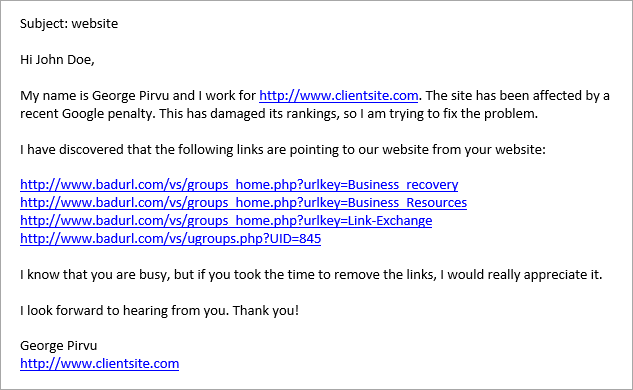
3. We wait for a week, and then we send a new round of emails to the webmasters that haven’t replied, offering them money in exchange for link removals.
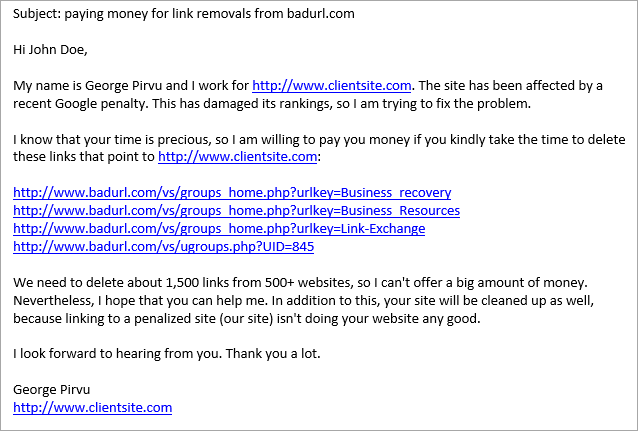
Once again, I am not paying the absurd $200 / link fees that some webmasters are asking. Just think about removing 5,000 links for a client – you’d need to spend a million dollars to get rid of them all! You can expect to pay hundreds to thousands of dollars for link removals, depending on the number or toxic backlinks.
The second email will get another round of links removed. Don’t expect miracles, though; the total link removal rate will be somewhere in the 30… 70% range, but this is often times enough to lift even a manual penalty, which is more severe.
Some people skip the 1-3 steps, using automated tools to create lists of toxic links, and then disavowing them. If you don’t remove as many links as you can, the chances of lifting a Penguin penalty are very slim. Doing things manually takes a lot of time, but it’s the only approach that maximizes your chances of getting the penalty lifted.
4. It’s time to create a links disavow file for all the domains where we couldn’t get the links removed, and then upload it to Google’s link disavow tool. Here’s a typical link disavow sample:
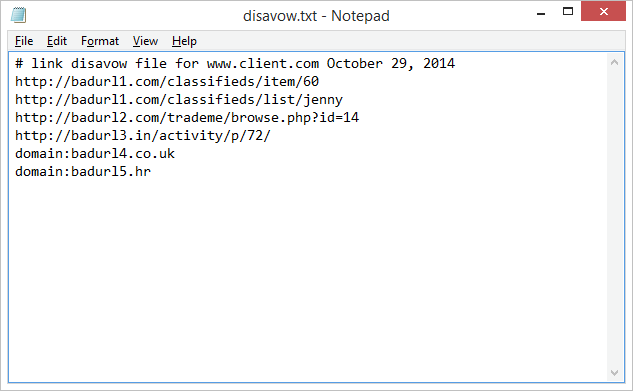
As you can see, we can disavow URLs or entire domains. As a general rule, you should only disavow entire domains if they are really, really spammy.
Google will let you know if your link disavow file upload was successful.
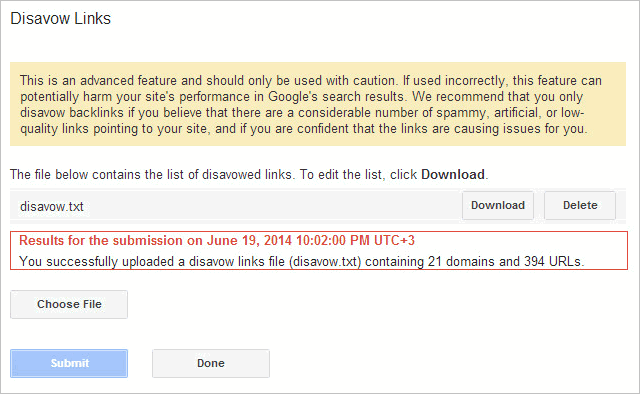
OK, so these are the steps that should get you out of a Penguin penalty; in fact, I am using a similar method to get clients out of manual penalties as well. For more information regarding manual (unnatural links) and Panda penalties, you can read the Google Penalties: Info and Recovery article.
If you have been affected by a Penguin penalty, you can only regain your rankings at the following Penguin algorithm refresh. And these Penguin updates don’t take place too often, I know, but Google has promised that it is going to increase their frequency in the future.
Just keep an eye on your website’s organic traffic level after the next Penguin update; if you see that it starts to grow, the penalty was lifted.
Your site may not regain its glorious rankings even if the penalty is lifted. You have removed many links, after all, and some of them, despite being spammy, were actually helping it rank better. Nevertheless, your website will be penalty-free, so you will be able to start promoting it again.
So is there anything else that you can do after you have submitted the links disavow file and you are waiting for the next Penguin update?
Sure thing! Create great content regularly and promote it using your social media accounts. You want to build additional website traffic channels that will help your online business survive even if your website is penalized.
Then, do your best to attract high quality backlinks from websites that have a huge authority. Check out Randombyte’s Buy SEO Services page to see how we do it. This way, your rankings will get a great boost as soon as the penalty is lifted. Not only that, but each new high quality backlink increases your site’s immunity to negative SEO attacks.
Great backlinks can even counter the negative effect of the spammy links that you may have built in the past, so they maximize your chances of having the penalty lifted as well.
If everything else fails, start an AdWords campaign; that’s what Google wants you to do, after all. This way, you will be able to compensate the website traffic loss and (hopefully) continue to make some profit.
Future Proofing Your Website against Future Penguin Updates
But let us assume that your site hasn’t been affected by Penguin; is there anything that you can do to future proof it against the following Penguin updates?
Here we go again: start writing and posting at least a few articles per month on your blog. Share them with the entire world using your Twitter, Facebook, LinkedIn and Google+ accounts.
Then, get backlinks that your competitors are unable to get because they are too lazy or because they don’t have the needed budgets. Keep your anchor text branded; use URLs for anchor text as well.
If you really want to use keyword-rich anchor text for your links, go for a long tail anchor, and not for the exact match.
As mentioned above, each new high quality link strengthens your site, making it less susceptible to penalties.
Stop building irrelevant, spammy links. If you use public link sources, you are exposing your site to a great risk. And if the link that you are trying to create is not surrounded by high quality content, it is worthless.
If you build links, keep the link velocity constant. Don’t build links every Thursday or so; Google will detect the pattern and will hit your site.
Conclusion
If you have been hit by a penalty, it may be a good idea to start a new site until the old one recovers. Avoid keyword-rich domains like my-cheap-shoes-store.com; it’s much better to purchase a related, and yet more generic domain like shoesincorporated.com.
By purchasing a new domain and setting up a new site right after a big Google algorithm update, you have the guarantee that it is 100% penalty free. Make sure to do a thorough research when purchasing expired, old domains, no matter how great they may look; lots of people are selling their penalized domains these days – and for a good profit!
Always work on diversifying your website traffic, as well as your income sources. You don’t want to build a business that only relies on Google for traffic.
This is true for you as well, Google: start diversifying. Your search engine is a great tool, but you won’t be able to continue to increase its profits on the long run. Stop penalizing us for bad links, and start rewarding us for good links. You have made it way too easy for competitors to launch negative SEO attacks and destroy small businesses overnight.
If you read this, Google, it’s time to start innovating again, creating the fresh, useful, revenue producing applications we have loved in the past. People will start to like you again and the shareholders will be happy as well. Please don’t be evil, Google.
As you now know, penalty recovery is a complex process that takes a lot of time. This article has provided all the needed info, giving you the opportunity to fix any penalty by yourself. Nevertheless, if you lack the needed time and your website is a crucial business asset, you should contact us.

